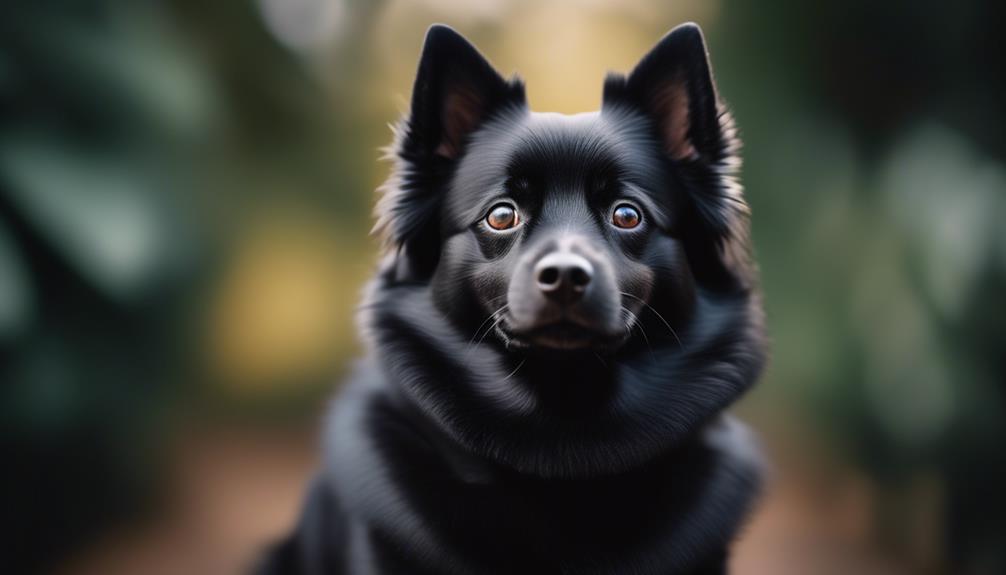
Have you ever wondered what makes the Schipperke dog breed so unique and captivating? With its distinctive appearance and lively personality, this small Belgian breed has piqued the curiosity of many dog enthusiasts.
From their spitz-like features and thick black double coat to their high energy levels and mischievous nature, there is much to explore and discover about the Schipperke.
So, let’s delve into the world of this fascinating breed and uncover the key information and characteristics that make them stand out from the rest.
Key Takeaways
- The Schipperke is a small Spitz breed originating from Belgium, known for its active and curious personality.
- They have a thick black double coat and require moderate grooming, including weekly brushing and occasional baths.
- Schipperkes are generally healthy, but they may be prone to certain health conditions such as Legg-Calve-Perthes Disease and Patellar Luxation.
- When properly socialized, Schipperkes can be friendly and affectionate with family members, children, and other pets. However, they may be protective and suspicious of strangers.
Origin and Size
The Schipperke, a small breed with origins in Belgium, is known for its distinctive size and appearance. This breed falls into the small breed group and has a compact and sturdy build.
Males typically stand between 11 to 13 inches tall and weigh 15 to 18 pounds, while females are slightly smaller, measuring 10 to 12 inches in height and weighing 11 to 15 pounds. These dogs have a thick, black double coat that requires moderate grooming to keep it in good condition.
The Schipperke is generally a healthy breed, but they can be prone to certain health issues such as Legg-Calve-Perthes Disease, Autoimmune Thyroiditis, Epilepsy, and Patellar Luxation.
Despite their small size, they have high energy levels and an active personality, requiring daily exercise and mental stimulation.
See another Dog breed profile.
Schnoodle Dog Breed
Lifespan and Coat
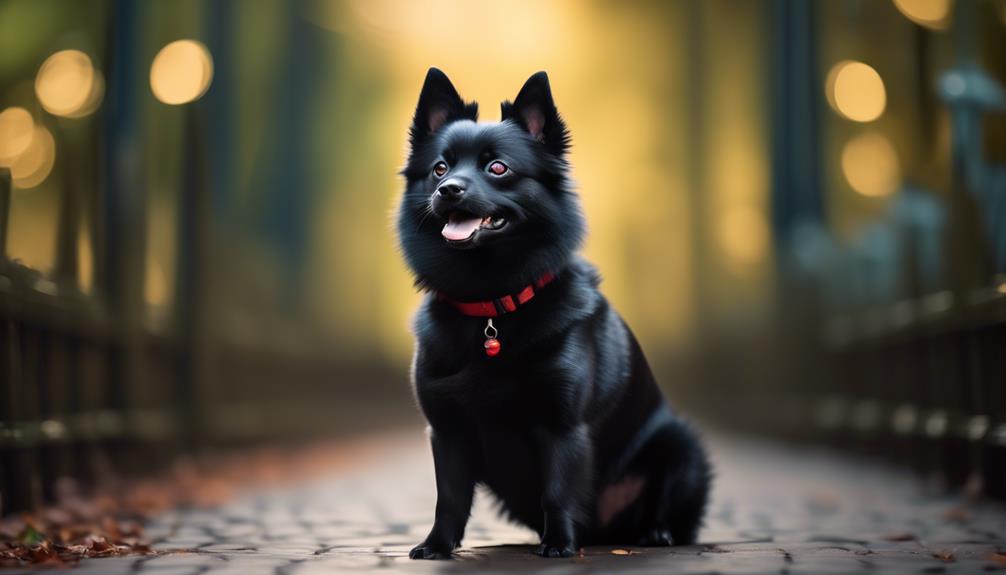
With an average lifespan of 12 to 14 years, the Schipperke is known for its thick, black double coat. This coat is one of the breed’s most distinctive features and provides protection against the elements.
The Schipperke’s double coat consists of a dense, soft undercoat and a longer, harsh outer coat. The combination of these two layers helps to keep the dog warm in cold weather and repel water. While the Schipperke’s coat is primarily black, some individuals may have small patches of white on their chest or toes.
Grooming the Schipperke’s coat requires regular brushing to remove loose hair and prevent matting. Occasional bathing is also necessary to keep the coat clean and healthy.
Health and Maintenance
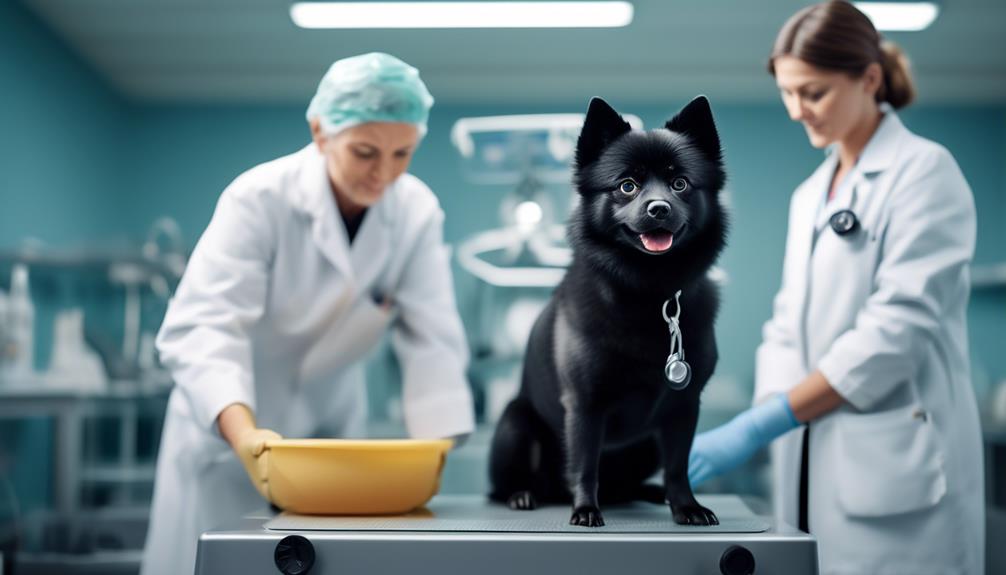
To ensure the health and maintenance of a Schipperke, it is important to provide regular veterinary care and a balanced diet. This breed is generally healthy, but they are prone to certain health conditions such as Legg-Calve-Perthes Disease, Autoimmune Thyroiditis, Epilepsy, and Patellar Luxation. Regular check-ups with the veterinarian can help detect and manage these conditions early on. Additionally, Schipperkes have high energy levels and require daily exercise and mental stimulation. They have a relatively low-maintenance grooming routine, with weekly brushing and occasional baths. However, dental hygiene and nail care should not be neglected. In summary, proper care and maintenance, including regular veterinary visits, a balanced diet, exercise, and grooming, will help keep a Schipperke happy and healthy.
| Health Conditions | Exercise and Mental Stimulation | Grooming |
|---|---|---|
| – Legg-Calve-Perthes Disease | – Daily exercise and playtime | – Weekly brushing |
| – Autoimmune Thyroiditis | – Mental stimulation through interactive toys | – Occasional baths |
| – Epilepsy | – Training sessions and obedience classes | – Dental hygiene and nail care |
Personality
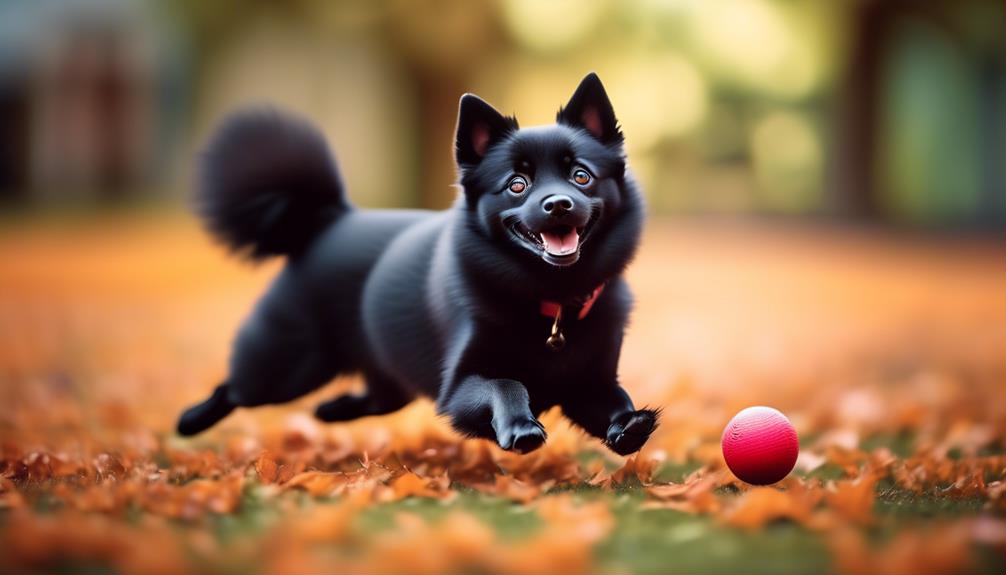
Active, confident, and curious, the Schipperke is a small Spitz breed known for its distinctive black double coat and mischievous personality. This breed has a unique combination of traits that make it an interesting and entertaining companion.
Here are some key aspects of the Schipperke’s personality:
- Mischievous and stubborn: Schipperkes have a playful and mischievous nature, often getting into trouble with their curious minds. They can be stubborn at times, but with positive reinforcement and consistent training, they’re quick learners.
- Protective and fearless: Despite their small size, Schipperkes are courageous and protective. They’re suspicious of strangers and will alert their owners to any potential danger.
- Selective in offering friendship: Schipperkes may take some time to warm up to new people and can be selective in choosing their friends. Once they form a bond, however, they’re loyal and affectionate companions.
With their lively and spirited personality, the Schipperke is a delightful breed for those who enjoy an active and mischievous companion.
Adaptability and Living Conditions
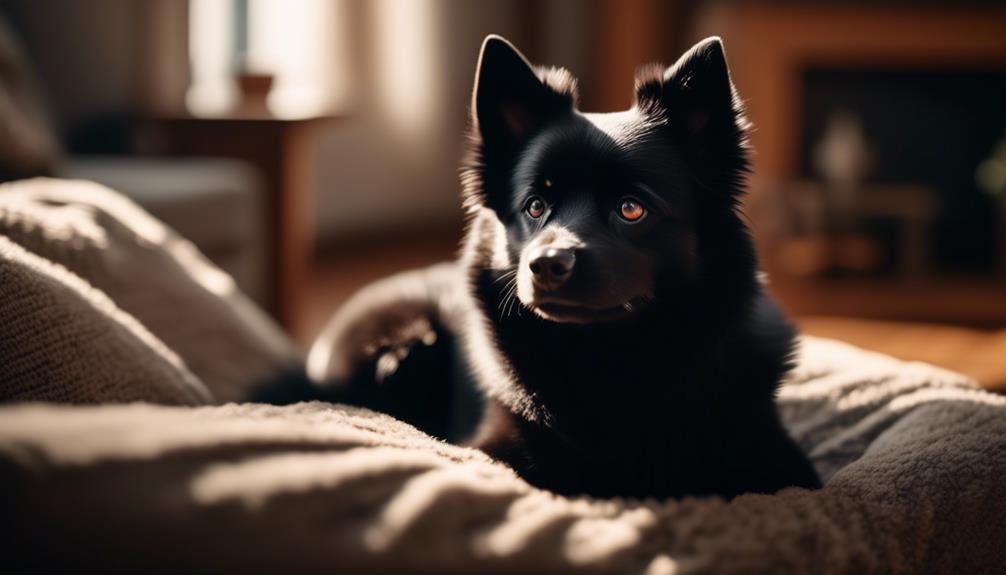
The Schipperke is a breed that adapts well to different living conditions, making them a versatile choice for various lifestyles. Whether they live in an apartment or a house with a small yard, Schipperkes can thrive as long as their exercise needs are met. However, it is important to note that they do not tolerate hot weather well, so extra precautions should be taken during the summer months. To help visualize the adaptability of Schipperkes, here is a table showcasing their suitability for different living conditions:
| Living Condition | Suitability |
|---|---|
| Apartment | Yes |
| House with Yard | Yes |
| Hot Weather | No |
This table serves as a quick reference guide for potential owners, allowing them to determine if a Schipperke is the right fit for their living situation.
Socialization and Compatibility
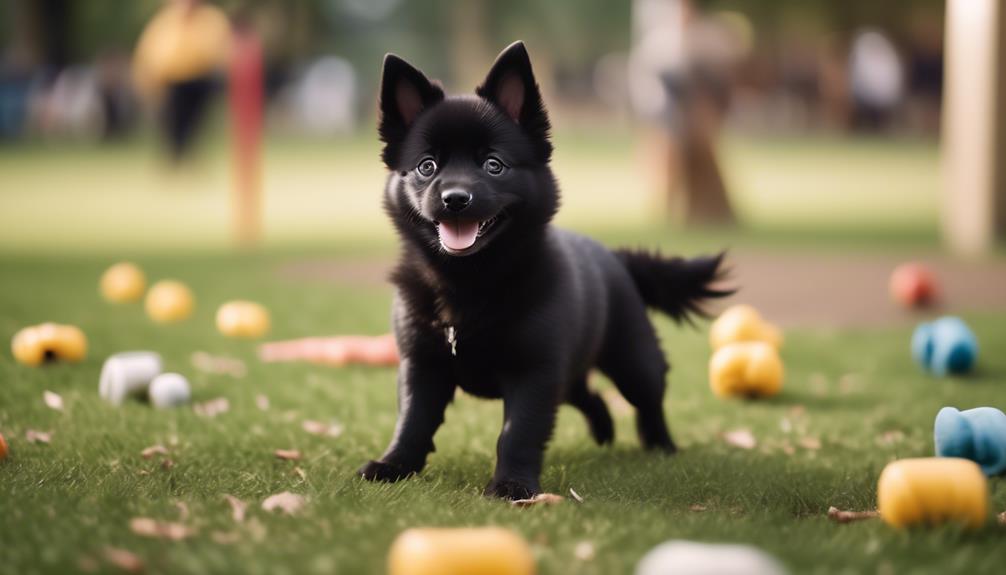
Schipperkes are known to be affectionate with their family and are generally good with kids, making them a compatible choice for households with children. When it comes to socialization and compatibility, Schipperkes tick all the right boxes.
Here are a few key points to consider:
- Dog friendly: Schipperkes are generally friendly towards other dogs and can get along well if properly socialized.
- Friendly towards strangers: While they may be suspicious of strangers, they’re generally friendly towards them once properly introduced.
- Friendly towards other pets: With proper socialization, Schipperkes can live harmoniously with other pets, including cats.
These qualities make the Schipperke a great choice for families looking for a loving and adaptable companion that can socialize well with both human and animal counterparts.
Care and Maintenance
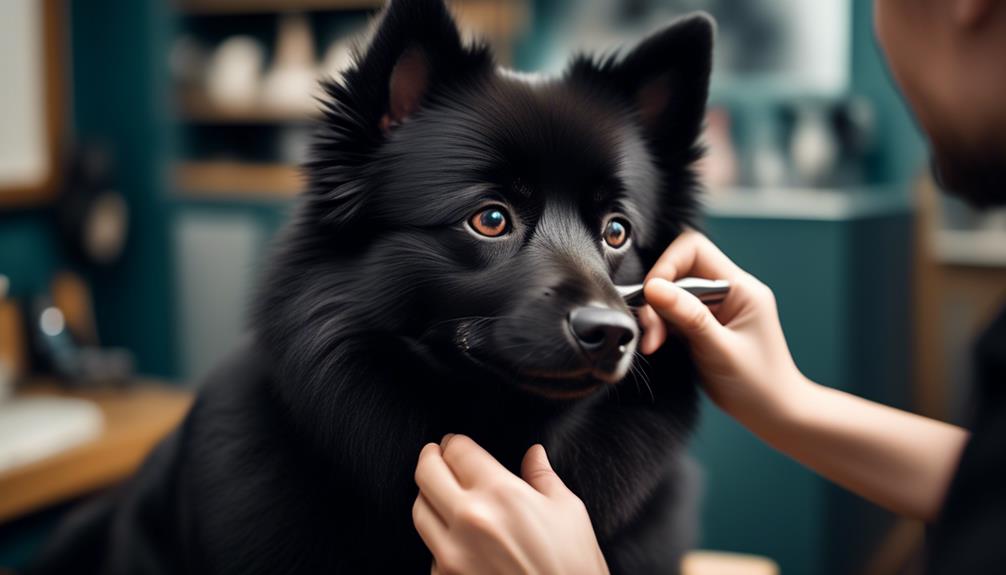
After discussing their socialization and compatibility, it’s important to understand the care and maintenance required for Schipperkes. These dogs should live indoors with their family and need daily exercise and consistent guidance.
When it comes to feeding, it’s recommended to provide them with a daily amount of high-quality dog food, measured and fed twice a day to prevent overeating.
The Schipperke’s distinctive coat, which comes only in basic black, requires weekly brushing and occasional baths, as well as regular dental hygiene and nail care.
In terms of their interaction with children and other pets, Schipperkes can be loyal and affectionate companions to children of all ages. They generally get along well with cats, and may get along with other dogs if properly socialized.
Frequently Asked Questions
Are Schipperkes Prone to Any Genetic Health Issues?
Schipperkes are prone to genetic health issues such as Legg-Calve-Perthes Disease, Autoimmune Thyroiditis, Epilepsy, and Patellar Luxation. However, they are generally a healthy breed and can lead a happy and active life with proper care.
How Often Should a Schipperke Be Groomed?
A Schipperke should be groomed regularly to maintain their distinctive black double coat. Weekly brushing and occasional baths are recommended, along with dental hygiene and nail care.
Can Schipperkes Live in Hot Climates?
Yes, Schipperkes can live in hot climates, but they tolerate hot weather poorly. It is important to provide them with shade, plenty of water, and to avoid exercising them during the hottest parts of the day.
Do Schipperkes Get Along With Other Dogs?
Schipperkes generally get along with other dogs if they are properly socialized. They can be friendly and accepting, but it’s important to introduce them gradually and supervise their interactions to ensure compatibility.
Are Schipperkes Suitable for First-Time Dog Owners?
Schipperkes can be suitable for first-time dog owners. They are quick learners with positive reinforcement. However, they have a mischievous and stubborn nature, so consistent guidance and daily exercise are important.
Conclusion
In conclusion, the Schipperke is a lively and versatile dog breed that brings joy and companionship to any family.
With their distinctive appearance and energetic personality, Schipperkes are known for their intelligence and mischievous nature.
They require daily exercise and mental stimulation, but their grooming needs are relatively low-maintenance.
Whether living in an apartment or working as a loyal companion, the Schipperke is a wonderful addition to any household.




